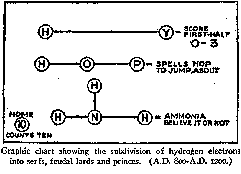
Graphic chart showing the subdivisions of hydrogren electrons into serfs, feudal lords and princes. (A.D. 800-A.D. 1200).
from Pluck and Luck
To appreciate the rapid strides which the science of chemistry has made in the last fifty years all one has to do is to think back on the days when we all, like a lot of poor saps, believed that the molecule was the smallest division into which you could divide matter. Then someone came along and proved that the molecule itself could be divided into something called atoms. Well, the relief we felt at this announcement! Everyone went out and got drunk.
Then came another scientist (he married a Cheever), who said that if you honestly wanted to get down to the fine points of the thing you could divide the atom up into much smaller units. This tiniest of all divisions of matter he called the "electron", after his little daughter Tiny, she being the smallest one in his family.
This seemed to be just about final, for the man said that an electron was a particle of negative electricity (one which knows when to say "No"), and that a "proton" was a particle of positive electricity, and that if you didn't believe it you could go and look for yourself. So it seemed pretty definitely settled that the electron was as small as you could get, and that unless you were crazy you wouldn't ever want to get even that small. So people began to put on their coats and hats and started to go back to work.
But that just shows. Now comes a Dr. Ernest J. Flazzer, of the University of Carlsbad, who declares that the electron is susceptible of being divided still further, and that, what is more, he has done it, right on his own porch. He calls the new subdivision "traffets", and claims that there are eight or ten million of them in one electron.
This practically revolutionizes modern chemistry. Modern chemistry has been revolutionized seven times now. The discovery of the traffet means that we shall have to go back over all the researches that we have made in the past fifty years, and throw away all that nice stuff in the test tubes.
For instance, in the old days, when you passed an electric current through water (H20), the free atoms of oxygen went in one direction and the free atoms of hydrogen went in the opposite one. At the count of ten they were supposed to turn around and see who had gone farthest. This game was called "Peek-o".
It was the same with a gas. A molecule of CO2 was the seat of such activity and good-natured rivalry on a pleasant day that you could hear the shouts a mile a away. Every one had a good time in a molecule of CO2. That was before even electrons were heard of. Just horse-cars. There were no jazz bands, and when any one wanted a drink, he took it.

Graphic chart showing the subdivisions of hydrogren
electrons into serfs, feudal lords and princes. (A.D. 800-A.D. 1200).
The introduction of the traffet into the scene, however, changes all that. Let us say that you have a combination of 72 atoms of carbon, 112 atoms of hydrogren, 18 atoms of nitrogen, a pony of brandy, and orange juice. It sounds all right, you say. Yes, but that's because anything with a pony of brandy in it sounds all right. The trouble is that you can't trust the hydrogen you get these days. It may be anything.
Now the division of electrons into traffets makes the formation of crystals almost impossible. You know crystals. For while you can pass a colloid (white of an egg, for example) through paper, a crystalloid (such as pencils) will not go through. This is because the atoms of hydrogen, coming into conjunction with the atoms of oxygen, refuse to go any farther without some assurance that they aren't going to be made suckers of and subdivided again by the next analyst that comes along. You can't blame them.
Lord Kelvin once said that the presence of 1/10000th part of bismith in copper would reduce its electrical conductivity so as to make it practically useless. A lot of people laughed when Lord Kelvin said this, but now they are laughing out of the other side of their mouths, for, bismuth or no bismuth (see the famous cartoon in Punch called "Dropping the Pilot", showing the Iron Chancellor himself being discarded by the young Emperor), the fact remains that during electrolysis you have to be very, very careful about catching cold. Of course, there is a always a chance that Dr. Flazzer may not be right, and there may be no such things as "traffets" in an electron. The awful part of it is, there is no way of every finding out whether he is right or not. Once you start questioning these things, you end up back in the brute state with no science at all.
| back to the Benchley page. |  Home |
About this site |